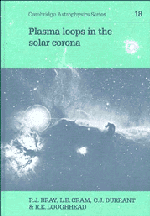Book contents
- Frontmatter
- Contents
- Preface
- Acknowledgements
- Other books by the authors
- List of abbreviations
- 1 Historical introduction
- 2 Cool loops: observed properties
- 3 Hot loops: observed properties
- 4 Flare loops: observed properties
- 5 Structure, dynamics and heating of loops
- 6 The plasma loop model of the coronae of the Sun and stars
- Additional notes
- Name index
- Subject index
3 - Hot loops: observed properties
Published online by Cambridge University Press: 22 October 2009
- Frontmatter
- Contents
- Preface
- Acknowledgements
- Other books by the authors
- List of abbreviations
- 1 Historical introduction
- 2 Cool loops: observed properties
- 3 Hot loops: observed properties
- 4 Flare loops: observed properties
- 5 Structure, dynamics and heating of loops
- 6 The plasma loop model of the coronae of the Sun and stars
- Additional notes
- Name index
- Subject index
Summary
Introduction
As we have seen in the preceding chapter, observations made in cool visible and EUV lines have provided extensive information on the large-scale systems of loops which dominate the structure of the lower corona above active regions. The loops are believed to trace out closed lines of force of the magnetic field which protrude up from beneath the photosphere and expand to fill the whole of the coronal volume above an active region. Hence a picture of the loop systems gives us some insight into the three-dimensional configuration of the magnetic field. But the picture obtained from observations of cool loops is far from complete. For more detail we have to turn to observations of hot loops, filled with material at coronal temperatures of a million degrees or more; these form the subject of the present chapter.
Emission from material at coronal temperatures dominates the EUV and soft X-ray regions of the solar spectrum. The lack of any appreciable photospheric or chromospheric emission at these wavelengths enables the corona to be viewed directly against the disk and, in fact, most of the available information on hot loops has been obtained from such (space) observations. In addition, other important contributions to our knowledge have come from the visible and radio regions of the spectrum. The line and continuum radiation emitted by the corona in the visible region is many orders of magnitude too faint to be detected on the disk against the glare of the underlying photosphere.
- Type
- Chapter
- Information
- Plasma Loops in the Solar Corona , pp. 92 - 165Publisher: Cambridge University PressPrint publication year: 1991



